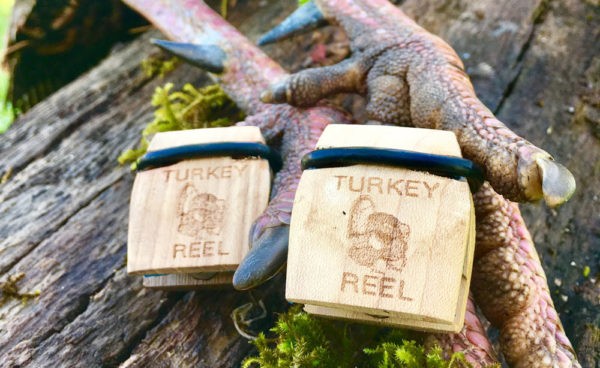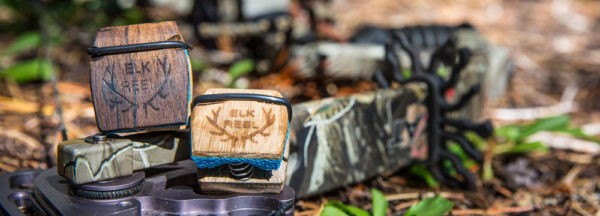
How do hunting calls work?
Our knowledge comes from years of hunting with every conceivable kind of call. We were always searching for something better. From sticky reeds to hard to use calls we tried em all. For Elk, Deer, Turkeys and more we have always preferred to call them. There is just something about using a game call to lure your quarry. An in-depth and broad reaching subject. Understanding how hunting calls work could fill a book.
We set out to make something that solved all problems in our Reel design. Once we came up with what we thought was an original design that does exactly that. We had to prove it and that brought us to a long patent process. We have read many patents from the last 200 years. On everything from toy noise makers to game calls that are currently popular.
With having read so many patents for game calls. We understand the inner works of what generates the sound and makes your hunting calls work. While we were writing and going through the patent process. As well as years of spending every free second calling game. We have an intimate knowledge of how these devices work.
How do hunting calls work? It is a broad question but it is surprisingly a narrow subject.
Many hunting calls for different species are similar. The mechanisms for generating sound are adaptable. They can be adjusted to imitate multiple species. What makes hunting calls work for one species can make them work for another.
From duck calls to deer calls, turkey calls to elk calls, and so on. How do calls work? We will run through how some of the more popular designs function. We will go into depth on what makes hunting calls work.

How do mouth reeds work?
The current mouth reed design uses a small aluminum frame that is shaped like an oval. It is bent into a semi circle around a flat flexible membrane. Leaving the edge of the latex between the bottom of the arch that is formed exposed. The exposed taught edge vibrates when air is blown off the plane of the membrane and over its free edge.
Currently latex is the most popular membrane material. There can be one or multiple membranes stacked so one slightly overhangs. Or sometimes just stacked vertically. There are many different ways to install the membranes or reeds.
Tape is then used to make the call block the airflow. A piece of tape in the original shape of the aluminum is folded around the frame. The call looks roughly the same shape as the bite of your mouth. Think a sharkbite out of a surfboard, with tape covering everything but the reed. The structure that makes these hunting calls work is simple.
How to use mouth reeds
The reed call is placed in the roof of the mouth with the reed facing the teeth. The user uses their tongue to direct the airflow under the reed. A combination of airflow control and tongue pressure controls the volume and pitch.
Due to the stretch of the reed they are easier to use with a higher volume of air. The start up velocity of the reed makes low volume sounds more difficult.
They can be cut in a myriad of geometrical fashions on the exposed edge of the upper reed. This allows the vibration pitch to lower as the reed vibrates slower. Combining this with a uncut reed or several allows multiple pitches to be played.
The uncut reed vibrates at the high rate underneath the overhanging upper one. A dampening reed can be added to make the sound more realistic.
These cut multiple reed calls were popularized for Turkey hunting originally. They make the high to low yelps of a hen turkey. With their multiple reeds providing excellent high front end and raspy back end notes.
An uncut single or double stacked reed produces a higher pitch. It is easier to use than a cut reed and many people learn with uncut reeds. They are excellent for hunting falls turkeys. They can also be used for other animals… mainly Elk

How do mouth calls work for Elk calling?
At some point someone realized that they could be adapted to Elk Calls. We researched the subject and the history is vague. Some of what we could find mentions Wayne Carlton of Montrose Colorado popularizing their use.
We will publish a follow up article on this page someday perhaps on an in depth history of elk Calling. We are excited to do some real fact finding on the subject.
However what was once a latex turkey call can be taken by a skilled user and made to make Elk vocalizations. In the early 80s this became increasingly popular to use and many hunting call companies quickly caught on.
Rocky Jacobson popularized a palate plate configuration in the early 90’s that adds some control to the call. He sold his patent application to Will Primos back then. The two have been making them ever since with their respective companies.
The palate plate is a structure that sits up above the reed. Whether a metal tab that bends up from the aluminum frame. Or a dome structure that spans above the aluminum frame.
The palate plate or dome over the reed keeps it from stretching too far. It limits the user to only reaching a high note of a certain pitch. The reed stretches with the tongue being placed up on it and the pressure being increased. The vibrational rate increases as more pressure is applied so the pitch elevates.
A single reed or double reed configuration with the upper reed extended beyond the lower are popular. They can be used with a grunt tube to change the pitch and amplify the sound effects the user is making. Especially when Bugling. All shapes and sizes of tubes have been tried over the years.
Bugling with a mouth call
A bull Elk is a massive animal, weighing up to 1000 pounds. They have a deep guttural sound they make due to the size of their lungs and the long windpipe and mouth. The bugle or grunt tube helps mimic this.
Though when a herd bull elk shakes the forest around you with a thunderous challenge bugle. He leaves little doubt that it is not a sound made by a man. We are sure there are some world champion elk callers that will not agree. So be it, not everyone will agree on anything.
This fact alone is why we choose to be more lovers than fighters when elk calling. In our part of hard hunted OTC territory here in colorado at least. Our reel calls allow you to sound so spot on like a cow or calf elk and that also influences our approach.
We do bugle sometimes to get a long distance response. Or if we are close enough to see the bull in heavy timber for example. We do this when we want him to think another bull is in between him and the low volume chirps we’ve made. Our calls allow you to call super quietly to make him think his cows are further away.
The only other time we bugle is to pretend we are a couple of juvenile bulls. As in just a herd hanging out in a happy herd scenario. However if they will respond to you just making cow and calf vocalizations probably don’t bugle.
Opinions on how good we bugle vary
Why? Give the elk the most realistic sounds we think and humans just do a better female elk. Some people may argue and some people love to bugle, and if it works for you then keep dropping em! We know plenty of guys that bugle in bulls so it is just a matter of personal preference.
It is just the fact we don’t weigh 800 pounds coupled with our personal experience. We have spent an awful lot of time on OTC public land and hear more fake bugles every year than you can imagine.
The user of an Elk mouth reed uses a lot more tongue pressure to control the call than a turkey mouth call user. Long airflow notes with sliding pressure changes and voice inflection are more common.
A user takes a deep breath and starts with a grr sound then works the call adding pressure from below an increase in air and cuts the voice inflection. The note soars as pressure is applied and it and increased airflow increases the vibrational rate of the reed. The pitch drops as the user reduces pressure. To end the note you can add a growling grunt.
It takes skill to bugle with a mouth reed. Trying to sound like the king of the forest with a mouth call takes real skill and years of practice.
The abrupt air flow cut offs of a Turkey hen cutting for example don’t come into play with elk talk. The practice of calling turkeys helps one to adapt to Elk calling. And vice versa though it is not as common as going from turkeys to elk.
Hard to use and fragile design
All mouth reed calls we have come across take skill by the user. They are not very durable, the metal gets easily bent, the reed wears out quickly. Putting a tape wrapped metal frame with organic latex rubber in your mouth speeds their demise.
The saliva in your mouth contains pre-digestive juices. Washing your mouth calls with clean water and carefully storing them helps. If there are multiple reeds drying them with toothpicks in between the reeds is a good plan.
Plan on going through and replacing your mouth reed calls. They are relatively cheap but you’ll buy a few a few times every spring and fall every year. They seem to stretch and get out of tune relatively fast. We quickly recognized they are not as economical as they seem. It was one of the issues we took into account when designing our current and future calls.
Our current Reel calls have non organic reeds that have been proven to last for several elk seasons. They are easily replaced if you ever do damage them. Which is difficult given they are encased inside our calls, they seem to last and last.

Mouth calls for predator hunting
Mouth reeds are also used in predator hunting. They can be used to simulate a Coyote howl to lure in a territorial song dog. This takes some skill to do as the pressure needed is finite. They will also imitate dying prey animals such as rabbits and other small mammals.
As you can see the mouth reed call design is very versatile. It takes quite a bit of skill to operate and users practice for years to become experts. These type of predator hunting calls work in the hands of a master. It can be used in many applications but not quite so many as the next call design we will discuss.
Forward facing reed calls
The next few designs are based on one design in our opinion. A mechanism based on a reed facing into the airstream. The sound is created when it vibrates against a solid flat surface on one side. This is the basic idea behind open reed and closed reed calls. It has several advantages and disadvantages that we will also cover.
How do open reed hunting calls work?
An open reed call uses a piece of Mylar or similar plastic that is facing into the airstream. It sits on a ramp or sound board that resembles a popsicle stick that tapers into a cylinder. The top where the reed sits is flat. It has a hole bored into it that tapers as the ramp tapers.
The hole allows air to flow through the ramp and through the call itself. The reed is generally not as wide as the sound board. It however has the same oval popsicle stick shape at one end. It ends where the sound board ends into the barrel of the call.
The soundboard and reed can be exposed and may have a small rubber O-ring around it. The O-ring changes the effective length of the reed. Smaller reed gives a higher pitch etc. Some calls have o-rings that can be moved up and down, giving variable pitch. This can also be done by using your lips, teeth or fingers to hold the reed tight against the sound board.
The barrel amplifies the sound made, they are cylinders made of plastic or wood. They give an acoustic effect by providing a small chamber that the sound waves bounce around in.
How to use open reed calls
The user places the reed end of the call in his mouth and blows into the reed and effectively forces it to vibrate. Some air goes under it and through the call into the barrel. The faster and harder the pace of the blast of air the louder it gets. However there is a limitation to using these types of calls quietly.
The hard plastic reed has a very high start up velocity compared to reed in our Reel. It is hard to get accurate sounds and pitch changes due to the stiffness of the reed. Simple physics dictates the performance of these calls is better at a higher volume.
They stick and they are unpredictable because of that fact. The two pieces of plastic, the sound board and the reed will stick to each other. Moisture is the open reed calls enemy, the moisture causes a bond to form between the two surfaces. Add cold and the effect is increased rapidly when it freezes.
Our reel calls will work after dunking them in water. You will not have a problem with reeds sticking or an unpredictable nature. Your call will just work and that is one of the biggest problems we had when elk calling.
How much effort both time and money does it take to get a shot at a bull? We wanted to make something that wouldn’t be a variable. The Reel just works 100 percent of the time and we are very proud of that.
Open Reed Versatility
Calls based on this Open Reed design are used to hunt Elk, Predator, Sika and Roe Deer to name a few. The forward facing plastic reed open reed calls allow a user to have a decent amount of pitch control. They can be used at quite a loud volume allowing one to call to distant critters.
The wide range of sounds mainly come from the ability to make these calls in different sizes.That could mean different ramp angles, bigger reeds or smaller, or just different shape reeds etc. All these things can vary to make these style of open reed hunting calls work for all kinds of hunting.
How do Closed reed hunting calls work?
A closed reed call uses a cylinder for the barrel and another around the sound board. This forces air blown into the reed end of the call to go thru the hole in the sound board. It goes under the reed and out the barrel. The reed vibrates against the soundboard without an O-ring or lips or teeth pinching it. This causes them to tend to make lower pitched noises than the open reed type call.
Duck and Goose calls use this design and the expired patent that covers these designs is almost 90 years old. The same shortcomings that plague open reed calls also affect closed reed calls. Moisture and high start up velocities are the same due to the same materials and reed configurations.
Deer calls for hunting also use this design to make both buck grunts and doe bleats. Sometimes the mechanism is reversed and a sucking motion is used to generate vibration in the reed. They suffer from unpredictability due to the stated issues with plastic reed type calls.
Even the can call can be considered a closed reed call. After all it is just a tiny little forward facing plastic reed and sound board inside it. The plunger falls and forces a certain amount of air through it at a controlled rate. Making it much more predictable than one you blow or suck through. This however means the call is monotone and can’t just be stuck in a pocket. It will go off when you move unless a cap is applied to the vent side.
Best new Deer call on the market!
Our Buck Reel call solves so many issues of previous doe bleat designs. It is extremely easy to use. It allows one to vary the volume and pitch and accurately make many doe and fawn vocalizations. Using it opens up a whole new world to Whitetail deer hunters, think a cow call for hunting elk.
It is so effective that during prototyping we had to warn hunters not to use it till you were able to see enough to shoot. So make sure you’re ready to kill a deer before you blow on one is our advice. Be in your chosen stand or blind or wherever and be setup. They will react to this call and be on top of you in an instant.
Closed Reed calls have been around a long time and they have even been adapted to use for many species. They have accounted for more waterfowl shot than anyone could imagine. Millions of hunters carry them to stands and blinds across the world.
How do Reel style hunting calls work?
Our design uses a reed that faces away from the airstream. It stretches a Nitrile Reed in a 3 dimensional shape that resembles a sail and bends over a lower structure to end in a flat reed. Underneath the reed is a complex geometrical design. Above the reed is a hinged foam lined lid that closes on a spring at the end away from your mouth.
When the two halves hinge together it effectively changes the size of the reed in smooth sliding manner. The sides pinch the reed as it closes then it pinches on the bridge underneath the exposed end of the reed.
What happens is rather complex but the mechanism is simple. It allows a high pitch when closed and a low pitch when open and every note in between.
Makes consistent sounds with low airflow
The reed catches air like a sail and allows the slightest amount of air to start it vibrating. It solves the high startup velocities of all other designs. The air is forced over the reed and vibrates it just like a mouth reed vibrates at its open end. However we don’t need as much tension as a mouth reed on our reeds. Our hunting calls work with a low startup velocity.
The hinging action controls the pitch and not your tongue creating a more taught reed to control pitch. Making for a predictable call on a level never imagined with mouth reeds or open and closed reed calls. Our type of hunting calls work for you. Not the other way around.
The hinging action takes the skill level way down. If you can blow thru the call and open and close the lid with your fingers you can use it. Its that simple really, does not require years of practice. Just minutes for our elk and deer designs is a common time frame to learn how to use them. We think in the future anything written about how hunting calls work will need to discuss the Reel.
How do Tube style hunting calls work?
A tube call is simply that. Imagine a tube the size of an empty toilet paper roll for example. Stretch a piece of latex over the top and leave a gap on one edge so you can still blow into the tube. Attach a rubber band around the end of the tube over the latex. The call you created can make a number of different animal vocalizations.
The operator simply puts his lip on the opening in the latex and uses airflow and pressure to cause the free edge of the latex to vibrate. These take skill to use but are simple and cheap to make. Some elk call companies use injection molded mouth pieces that take custom silicone reeds but the principle is the same.
The reeds can be easily torn and a cap is often used to protect them. They are unpredictable and there are quite a few variables in this type of bugle. This makes them capable of making a bad sound at the worst possible moment. Murphy’s law applies in the fullest extent in the Elk woods.
They are effective for Turkeys and Elk and we imagine a skilled user could use them as a predator call. You can make a homemade turkey tube call with a pill bottle. There are several plans available on the internet.Understanding the mechanism that
How do Friction Calls work?
A friction call works on just that, friction. There are a few types that we will list here. Mostly they are used for turkey hunting. Pot calls, box calls and push button calls are the most popular types. No article on how hunting calls work should leave out friction calls.
A pot call is a small wooden round box with a piece of round slate, glass or aluminum fitted inside it. A striker made of wood is used to scratch the surface to elicit sound. Think scratching a chalkboard with your fingernails. The surface must be kept clean and a piece of sandpaper is used to keep it roughed up. Too smooth and the striker just slides and doesn’t make noise.
A box call is a small wooden box with a lid that is hinged on one end. It is hinged so the lid can be drawn across the box from side to side. Both or one edge of the box has slate on the bottom and so will the bottom of the lid. Aluminum can be used etc to create the friction that creates the noise. Usually the box call is rectangular with a handle on the lid and bottom. The shape reminds me of a hairbrush.
A push button call is another small wooden box. It has a dowel drilled through it and the dowel has the striker glued to it. The scratching surface is attached inside the box so the striker rubs against it. The dowel is spring loaded it rests at the extended position. When pressed it scratches the striker. It is a very simple and easy call to use. It is relatively quiet and you must keep it clean like the other friction calls.
Old school game call designs
These friction type calls have been around a very long time. Useful to a turkey hunter and many hunters carry one or all three in their turkey vests. They all have advantages and drawbacks but if kept clean and dry and in good condition they make good turkey vocalizations. They take some skill to operate and can be unreliable if they aren’t in perfect running condition.
There are many other slight variations on these basic call designs. Just tried to touch on the ones we found most important. We hope you enjoyed this article on how hunting calls work. Try a Reel Game call and see why we think they are so much better.
https://www.youtube.com/watch?v=DQHlX_vs0Nw
We also suggest checking out some of our other articles like: When to use Elk Calls
Also: How to make Elk Calf Sounds
https://reelgamecalls.com/shop/elk-calls/reel-game-calls-hardwood/
https://reelgamecalls.com/shop/turkey-calls/reel-game-calls-turkey-reel/
